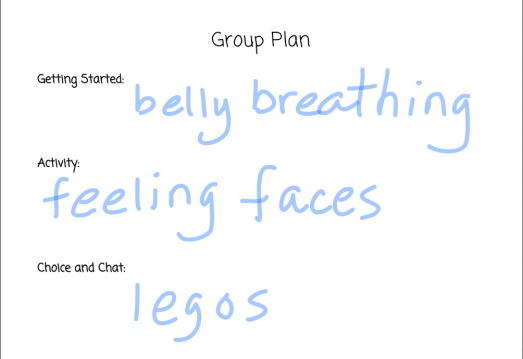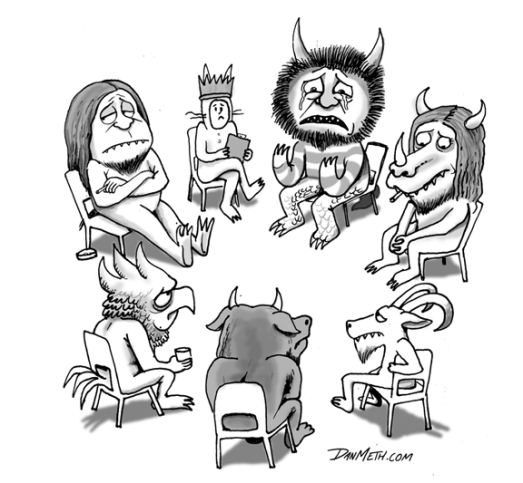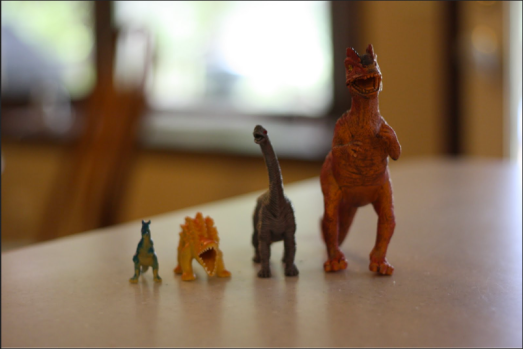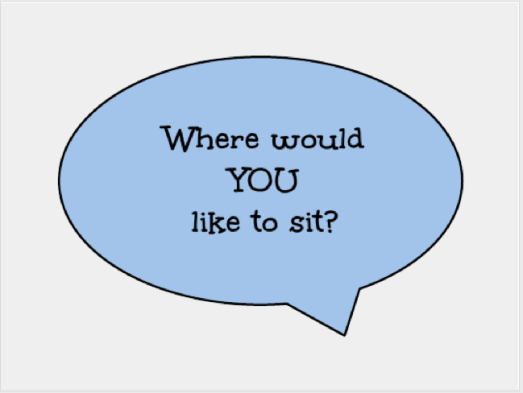 Let’s be real: group counseling can be really hard. No matter how carefully you build the group membership and plan lessons and activities, sometimes things do not go as expected. Here are some ideas that I have found to be most helpful:
Let’s be real: group counseling can be really hard. No matter how carefully you build the group membership and plan lessons and activities, sometimes things do not go as expected. Here are some ideas that I have found to be most helpful:
Think carefully about whether the group members are actually ready to be able to be in a group. Sometimes kids need some “pre-teaching” about things like how to listen, take turns, or manage their personal space. They may need a chance to get familiar with your group space and the items in it, or to learn that they will be safe there and with you before they have the added stressors of having other kids around or an audience. They may need to start out in a mini group of just one other kid – and maybe that kid needs to be a really strong, easy-going role model! And in some cases, individual counseling, with the goal of working toward being able to be in a group, is in the kid’s best interest.
Don’t let the group experience become “one more failure.” It can be heartbreaking when a group setting doesn’t work out for a kid – those kids are often the last ones who need to get the message that they don’t fit in. If things haven’t gone well for a particular student in the group, I generally talk with him/her about it after the group (but not always right after) to make a plan for the next session. I also check in with him/her the morning of the group to make sure that he/she remembers the plan and is all set to have a great group. Sadly, that is not always enough. If his/her behaviors negatively impact the group’s experience and learning, and you know you’ve tried your best to help him/her pull it together, then it’s time to have the kid leave the group and access your services in a different setting where they can feel more successful.
 Teach group skills. One of the ways that I help ensure group success is to actually teach kids who might have difficulty being in a group how to be in a group. This teaching takes place during the first one or two sessions (with lots of review in later sessions) and on our travels to and from the group. Yes, this adds on to the number of sessions that the actual group topic will take, but I have found it sooooo helpful in the long run, because the extra time spent inevitably leads to much better outcomes. My motto: If at all possible, try NOT to let the wild rumpus begin!
Teach group skills. One of the ways that I help ensure group success is to actually teach kids who might have difficulty being in a group how to be in a group. This teaching takes place during the first one or two sessions (with lots of review in later sessions) and on our travels to and from the group. Yes, this adds on to the number of sessions that the actual group topic will take, but I have found it sooooo helpful in the long run, because the extra time spent inevitably leads to much better outcomes. My motto: If at all possible, try NOT to let the wild rumpus begin!
 1. Walking down the hall. I pick everyone up at their classrooms and when we’re all assembled, tell them that we are going to play a walking game. The rules are that we have to stay in a group line all next to each other (I’m in the middle) and that I’m going to try to trick them into not being able to stay next to me. If we get all the way to my room still in a group line, they win. If we get there without all being together, I win. Then I proceed to take a variety of steps – regular ones, fast tiny shuffles, large strides, slow motion steps, one at a time, sudden stops, etc. – and they have to stay right with me. For some reason kids find this wildly fun! Inevitably, it is not easy at first, and I really do try to trick kids (a little bit) with my sudden stops and changes of pace, so that they can practice quickly correcting themselves and making sure they are part of the group. We play the same game when we head back to the classrooms. As everyone gets better at it, kids get to take turns being the leader.
1. Walking down the hall. I pick everyone up at their classrooms and when we’re all assembled, tell them that we are going to play a walking game. The rules are that we have to stay in a group line all next to each other (I’m in the middle) and that I’m going to try to trick them into not being able to stay next to me. If we get all the way to my room still in a group line, they win. If we get there without all being together, I win. Then I proceed to take a variety of steps – regular ones, fast tiny shuffles, large strides, slow motion steps, one at a time, sudden stops, etc. – and they have to stay right with me. For some reason kids find this wildly fun! Inevitably, it is not easy at first, and I really do try to trick kids (a little bit) with my sudden stops and changes of pace, so that they can practice quickly correcting themselves and making sure they are part of the group. We play the same game when we head back to the classrooms. As everyone gets better at it, kids get to take turns being the leader.
2. Spy on the room. Sometimes the door will be shut and I’ll open it a crack so we can peek in, sometimes I have the opening “barricaded” with chairs (or throw caution to the wind and just leave the door wide open and unguarded) and we make binoculars with our hands to spy with. I direct their attention to the table and chairs and ask them to report what they notice. How many chairs are there and why that number? What’s on the table? What clues do you see about what we are supposed to do next?
3. “Where would YOU like to sit?” I model saying this somewhat dramatically/formally with a little bow and outswept arm, which seems to distract kids from the terrible truth that they might not get to sit where they want. Giving them something to do in place of jostling for a chair works much better than just telling them not to push and shove. More often than not, the same character who would be most likely to make a grab for the seat of his choice wants to go first (which means asking first, not choosing first), so I let him. Oh what a tricky school counselor! The first kid asked chooses his seat and sits down, then asks another person, and so on until everyone is seated. I have fourth graders who still say this when they come into my room, even though they stopped needing to years ago. A social skills training technique has evolved into plain old politeness. Can’t beat that!
4. Brain and body in the group. This is a concept developed by Michelle Garcia Winner as part of her Social ThinkingTM curriculum. (More about this coming soon!) To have your “body in the group” means that your head, shoulders, and hips are facing the group or the person talking, and your arms, hands, legs, and feet are staying within your own personal space and not moving in a way that distracts yourself or others. Having your “brain in the group” means that you are thinking about what everyone else in the group is thinking about and staying on topic. To teach this concept, we play the Brain and Body in the Group Game, which I came up with out of desperation one day. This is another game, like the Walking Down the Hall Game that the kids love and never seem to tire of. I’m not quite sure why, but, who cares? They work! I also teach the Brain and Body in the Group game in all my first grade classes and pull it out of my bag of tricks as needed wherever and whenever kids need a reminder about paying attention and staying on topic. Usually all kids need is the cue “brain and body in the group!” and often they provide it to each other before I even need to!
Here’s a video of some friends showing how to play the game. (They’ve been begging me for feedback from my readers about how you liked learning how to play the game from them. They were quite enamored of the idea that they were going to be teaching school counselors! If you have a comment for them, please share.)
5. Choice and Chat Time. When kids are learning about how to be in a group (and for groups that continue to need the incentive) I plan Choice and Chat time for the last activity of each session. As with all groups, once everyone is seated, we go over our Group Plan for that session, using the iPad, Group Plan sheet or a small whiteboard (usually whichever one is faster to grab, since I’m often Guerilla Planning!) I’ve already filled out the “Getting Started” and “Activity” sections, but the kids have to decide together which choice they will do together.
 In early sessions of the group they may only have a choice of two or three previously selected activities, but later on they may be able to choose freely from art materials, toys, or games. I have found that adding Chat to the Choice time meant that we could put off (or avoid) the personal storytelling/griping that often took too much time during our check-ins at the beginning of the group. With some groups I go ahead and teach how to check-in briefly, but with some friends learning just this skill alone takes a lot of time, so I often leave the checking-in skill for another session/group/year and use Choice and Chat instead.
In early sessions of the group they may only have a choice of two or three previously selected activities, but later on they may be able to choose freely from art materials, toys, or games. I have found that adding Chat to the Choice time meant that we could put off (or avoid) the personal storytelling/griping that often took too much time during our check-ins at the beginning of the group. With some groups I go ahead and teach how to check-in briefly, but with some friends learning just this skill alone takes a lot of time, so I often leave the checking-in skill for another session/group/year and use Choice and Chat instead.
6. Peer Recognition. At the end of each session, I ask each kid to compliment another group member (I choose whom) for using a group skill: “You did a good job keeping your brain in the group,” “You did a good job deciding to do legos with us even though you first wanted to draw,” “You did a good using your fidget without distracting me” etc. Our school uses Otter Tickets to recognize caring, safe, and responsible behaviors. These are generally given by adults, so it is especially thrilling to group members that they get to give out an Otter Ticket with their compliment. Giving an Otter Ticket is sometimes just as rewarding as getting one!
I love running groups, but I love them a lot more when they don’t leave me feeling like I need an immediate nap and a long vacation on a tropical isle! Like everyone else, I’ve had my share of those group sessions (and still do sometimes), but using these strategies to help kids learn how to be successful group members has helped me be a more successful group leader. I hope they will help you too!
What do you do to help kids be more successful in groups?
You might also be interested in:
My Absolutely, Positively Most Favorite Counseling Game of All Time Throughout Eternity (So Far)
Treasure Boxes, Treasured Friends
Introduce Conflict Resolution with “The Zax”





Love those actors and actress!
Hey kids! Thank you for teaching me about “brain and body” in group. Now I know exactly what to tell my students. You guys are so smart!
Excellent ideas and wonderful video demonstration of “Brain and Body in the Group!” I will use this and also share with my graduate internship students! Thank you!
Awesome! I love these ideas! I actually just had a post about small groups too (http://www.elementaryschoolcounseling.org/1/post/2013/01/pixar-week-small-fry.html). Great minds this alike!
P.S. Your students did a FABULOUS job! For a second there, I thought they were 6th graders because they behaved so well.
Thanks for sharing this ever so timely post!! I am just about to start a new social skills group for 1st graders and these tips will be very helpful!
Also great job to your student actors!! The video clip really demonstrated the technique!!
WILD RUMPUS party of 1 describes one kiddo I had this week…I’ve been debating about what to do. The other kiddos in the group were getting pretty tired of his attention seeking ways and I want all of them to be successful. Your post is extremely timely and helpful.
Preteaching and setting up expectations is so critical! Great advice
Best Wishes!
Heather
Great video! Tell your students they did such a great job showing how to play the game that I showed it to my group in my school! We now play this to start every group.
This is a great post that will be useful to show our interns when starting group sessions.
When you see your actors again, please tell them thank-you for their hard work. I can’t wait for school to start so we can learn “Brain and Body in the Group.”
I loved the Brain and Body in the group! I’m going to use that! The kids did a great job clearly demonstrating how it works!